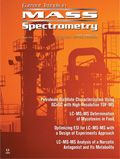Multi-Toxin Determination in Food: The Power of “Dilute and Shoot” Approaches in LC–MS–MS
Special Issues
This article provides useful tips for smooth validation of multi-analyte LC–MS-MS methods and summarizes important validation outcomes for 295 analytes, including more than 200 mycotoxins.
A liquid chromatography–tandem mass spectrometry (LC–MS-MS) “dilute and shoot” method for the determination of 331 (toxic) secondary metabolites of fungi and bacteria has recently been optimized and validated for different food matrices (1) according to the guidelines established in the Directorate General for Health and Consumer Affairs of the European Commission (SANCO) document No. 12495/2011. This article provides useful tips for smooth validation of multi-analyte LC–MS-MS methods and summarizes important validation outcomes for 295 analytes, including over 200 mycotoxins. The second part of this article focuses on the performance of the method in proficiency testing with an emphasis on difficult matrices. The z-scores obtained with this method were between -2 and 2 in 368 out of 408 cases for maize, wheat, triticale, bran, nuts, baby food, raisins, figs, coffee, liquorice, and hot pepper. From these results it can be concluded that quantitative determination of mycotoxins by LC–MS-MS based on a “dilute and shoot” approach is also feasible in the case of complex matrices such as such as pepper, coffee, or liquorice.
Spoilage of food and feed is still a global problem, leading to enormous annual losses of several hundred million tonnes. In relation to that, microscopic filamentous fungi are considered as one of the most feared agents because of mycotoxin production (2). Mycotoxins are low-molecular-weight, secondary metabolites of mold, and are toxic to animals and humans even in low concentrations (3). The European Union (and many other countries) has therefore established maximum levels for the most important mycotoxins in food (4). Such regulations can be laid down or amended only based on long-term occurrence monitoring and availability of toxicological data followed by exposure risk assessment. The European Food Safety Authority (EFSA) organizes a continuous call for data collection about the occurrence of already regulated (aflatoxins, ochratoxin A, deoxynivalenol, HT-2 toxin, and T-2 toxin) and so-far unregulated mycotoxins (nivalenol and ergot alkaloids) (5). Further collection of accurate data is also needed for enniatins, beauvericin, sterigmatocystin, Alternaria toxins, citrinin, and phomopsins for human and animal exposure assessment (6).
The increasing requirements for accurate and reliable occurrence data for more than one toxin has led to great progress in the development of highly selective, sensitive, and accurate liquid chromatography–tandem mass spectrometry (LC–MS-MS) methods for multi-mycotoxin determination in food and feed (7). A range of methods have been published on the identification and accurate quantification of single or chemically related mycotoxins in several matrices (8). However, the number of validated multi-analyte methods covering mycotoxins of different classes is limited for several reasons, beginning with sample preparation. The extraction solvent used has to solve a broad range of chemically unrelated toxins, and sophisticated cleanups have to be omitted to avoid discrimination of some compounds. Unspecific extraction and the reduction of sample cleanup to a minimum can result in suppression or enhancement of analyte responses during the ionization process. So-called matrix effects are a major challenge in successful development of reliable, quantitative multianalyte methods. Therefore, considerable efforts to control matrix effects should be performed to obtain accurate results. However, common approaches for counteracting matrix effects (unspecific QuEChERS cleanup, standard addition, matrix-matched standard addition, stable isotope dilution assay [SIDA]) are not feasible for LC–MS-MS methods covering more than 200 mycotoxins. In this case, injection of diluted extracts on a highly sensitive LC–MS-MS instrument has been shown to be the most effective approach (1).
Performing in-house validation is necessary for reliable quantification at a high level of trueness, preferably according to international guidelines. However, validation of each matrix that should be analyzed for around 300 substances is costly and time-consuming. The Directorate General for Health and Consumer Affairs of the European Commission (SANCO) document for development of multi-analyte methods in pesticides residue analysis recommends that at least one representative commodity from each commodity group should be validated and evidence for fitness of purpose should be provided (9). This approach, which was successfully applied in pesticide residues analysis, has also been followed for the validation of the developed multi-mycotoxin LC–MS-MS method (1).
Another difficulty in quality assurance of multi-mycotoxin LC–MS-MS data is the limited or even non-availability of certified reference materials containing multiple structurally unrelated mycotoxins. Therefore, participation in proficiency testing is the only option to prove the long-term performance of the method.
The objective of this article is to provide useful tips for smooth validation of multi-analyte LC–MS-MS methods, summarize the important validation outcomes, and present the long-term performance of this “dilute and shoot” method in the proficiency testing with a special focus on “difficult” matrices.
Experimental

Analytical Challenges in Measuring Migration from Food Contact Materials
November 2nd 2015Food contact materials contain low molecular weight additives and processing aids which can migrate into foods leading to trace levels of contamination. Food safety is ensured through regulations, comprising compositional controls and migration limits, which present a significant analytical challenge to the food industry to ensure compliance and demonstrate due diligence. Of the various analytical approaches, LC-MS/MS has proved to be an essential tool in monitoring migration of target compounds into foods, and more sophisticated approaches such as LC-high resolution MS (Orbitrap) are being increasingly used for untargeted analysis to monitor non-intentionally added substances. This podcast will provide an overview to this area, illustrated with various applications showing current approaches being employed.
New Study Reviews Chromatography Methods for Flavonoid Analysis
April 21st 2025Flavonoids are widely used metabolites that carry out various functions in different industries, such as food and cosmetics. Detecting, separating, and quantifying them in fruit species can be a complicated process.
University of Rouen-Normandy Scientists Explore Eco-Friendly Sampling Approach for GC-HRMS
April 17th 2025Root exudates—substances secreted by living plant roots—are challenging to sample, as they are typically extracted using artificial devices and can vary widely in both quantity and composition across plant species.

.png&w=3840&q=75)

.png&w=3840&q=75)



.png&w=3840&q=75)



.png&w=3840&q=75)










